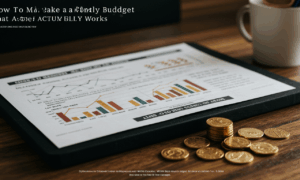Are you wondering where your money goes each month? Creating a personal budget is the single most powerful step you can take to gain control over your finances, reduce stress, and start achieving your financial goals. It’s not about restriction; it’s about empowerment. A budget is simply a plan for your money, a roadmap that guides your spending and saving decisions. This guide will walk you through, step-by-step, how to build a budget from scratch, even if you’ve never tried before.
Understanding your financial landscape is the foundation of a secure future. Without a clear plan, it’s easy to overspend or miss opportunities to save. By the end of this article, you will have a clear framework to manage your income and expenses effectively, turning financial uncertainty into confidence and clarity.
What Exactly is a Budget and Why Do You Need One?
Think of a budget as a detailed financial plan for a specific period, usually a month. It estimates your income and projects your expenses, allowing you to see exactly where your money is going. The primary goal is to ensure your expenses don’t exceed your income, enabling you to allocate funds towards what truly matters to you, whether that’s paying off debt, building an emergency fund, or saving for a big purchase.
Many people shy away from budgeting because they fear it will be restrictive and prevent them from enjoying life. In reality, the opposite is true. A well-crafted budget gives you permission to spend. It allocates money for both your needs and your wants, guilt-free. It’s the tool that helps you say yes to your priorities. Without one, you’re essentially flying blind, making it nearly impossible to make significant progress on your long-term savings goals.

Your Step-by-Step Guide to Creating a Budget from Scratch
Building your first budget can feel daunting, but it’s a straightforward process. Let’s break it down into five manageable steps. Grab a notebook, a spreadsheet, or a budgeting app, and let’s get started.
Step 1: Calculate Your Total Monthly Income
The first step is to know exactly how much money you have coming in each month. This is your foundation. Tally up all your sources of income after taxes (your net income or take-home pay). This includes:
- Your primary salary or wages.
- Income from any side hustles or freelance work.
- Any other regular income you receive.
If your income is irregular, a common situation for freelancers or those in sales, don’t worry. A good strategy is to calculate your average income over the last six to twelve months. Alternatively, you can build your budget based on your lowest-earning month to ensure you can always cover your essential expenses.
Step 2: Track Your Expenses Diligently
This is the most crucial—and often the most eye-opening—step. You need to figure out where your money is actually going. For one full month, track every single dollar you spend. It might seem tedious, but this data is essential for creating a realistic budget. You can do this by:
- Reviewing your bank and credit card statements.
- Keeping all your receipts.
- Using a notebook to jot down cash purchases immediately.
The goal here is not to judge your spending but simply to gather information. Be honest with yourself. That daily coffee, the subscription you forgot about, the impulse buy—it all needs to be recorded.
Step 3: Categorize Your Spending (Needs vs. Wants)
Once you have a month’s worth of spending data, it’s time to organize it. Group your expenses into categories. Start with broad categories and get more specific if you need to. Common categories include:
- Housing: Rent/Mortgage, utilities, insurance.
- Transportation: Car payment, gas, public transport, insurance.
- Food: Groceries, restaurants, take-out.
- Personal Care: Toiletries, haircuts.
- Debt Payments: Student loans, credit cards.
- Entertainment: Streaming services, movies, hobbies.
- Savings: Contributions to emergency fund, retirement, etc.
Next, divide these expenses into two main types: fixed expenses (costs that stay the same each month, like rent) and variable expenses (costs that change, like groceries or gas). This helps you see where you have more flexibility to make cuts if needed. The most powerful part of this step is to further label each expense as either a Need (something essential for survival, like housing and food) or a Want (something you enjoy but could live without, like a new gadget or dining out).
Step 4: Analyze and Create Your Plan
Now it’s time for some simple math. Subtract your total monthly expenses (from Step 2) from your total monthly income (from Step 1). This will result in one of three scenarios:
- You have a surplus: Congratulations! You are spending less than you earn. This extra money is a powerful tool. You can use it to accelerate your debt repayment, boost your savings, or even begin exploring investment opportunities.
- You break even: You are spending exactly what you earn. While you’re not in debt, you aren’t making financial progress. Look at your Wants category to see where you can trim spending to create a surplus.
- You have a deficit: You are spending more than you earn. This is a red flag that can lead to debt and financial stress. Go back to your categorized expenses. The first place to look for cuts is in your Wants. Can you reduce dining out? Cancel unused subscriptions? This is where your budget empowers you to make conscious decisions to improve your overall finance.
Step 5: Review and Adjust Regularly
A budget is not a set it and forget it document. Your life, income, and goals will change, and your budget should adapt accordingly. Plan to sit down for 15-30 minutes at least once a month to review your spending, check your progress, and make any necessary adjustments. This regular check-in keeps you engaged with your financial plan and helps you stay on track.
Common Budgeting Pitfalls to Avoid
As you start your budgeting journey, be aware of a few common mistakes:
- Being Too Restrictive: If your budget is so tight that you have no room for fun, you’re likely to abandon it. Be realistic and allocate some money for entertainment and hobbies.
- Forgetting Irregular Expenses: Annual subscriptions, holiday gifts, or car maintenance can wreck a monthly budget if you don’t plan for them. Create specific sinking funds where you save a small amount each month for these larger, less frequent expenses.
- Giving Up Too Soon: Your first month or two of budgeting will be a learning experience. Don’t get discouraged if you overspend in a category. Simply analyze why it happened and adjust your plan for the next month. Progress, not perfection, is the goal.
Building a budget is a foundational skill for financial wellness. It replaces guesswork with a concrete plan, reduces anxiety about money, and empowers you to direct your resources toward building the life you want. Remember, this information serves as an educational guide and should not be considered financial or investment advice.
Frequently Asked Questions (FAQ)
What if my income is irregular and unpredictable?
This is a common challenge for freelancers, gig workers, or those in commission-based roles. The best approach is to create a baseline budget based on your lowest anticipated monthly income. This ensures your essential needs are always covered. In months where you earn more than the baseline, you can allocate that extra income directly to high-priority goals like paying down high-interest debt, building up your emergency fund, or boosting your savings.
I’ve tracked my spending and it seems overwhelming. Where should I start making cuts?
The Needs vs. Wants categorization is your best tool here. Start with the Wants column. Often, the easiest and most impactful cuts are found in categories like dining out, subscriptions you don’t use, and impulse shopping. Look for small, recurring charges that add up over time. Cutting just a few of these non-essential items can often free up a surprising amount of cash without drastically changing your lifestyle.





